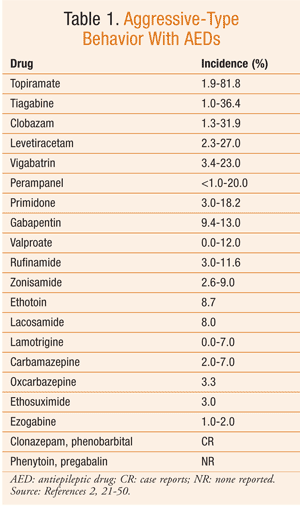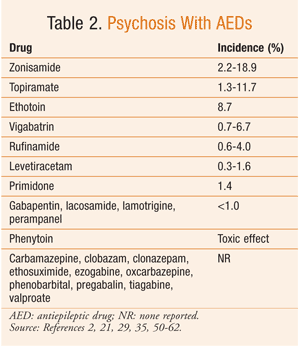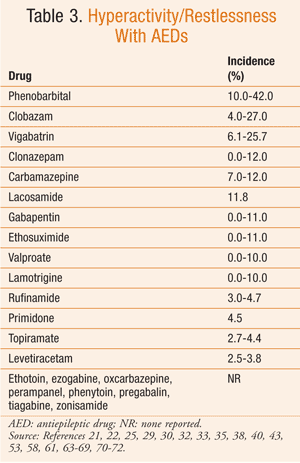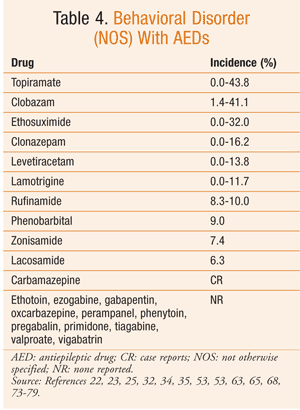Toxic effects of AEDs
Table:Properties of the AEDs
| Older AEDs | Daily Adult Dosage/Interval | Usual Adverse Effects | PBSE | Interactions |
|---|---|---|---|---|
| Carbamazepine | 400-1600+ mg (BID-QID) | Diplopia, dizziness, ataxia, hyponatremia | Carbamazepine is chemically related to TCAs and can rarely induced affective changes [depression and mania] | Bidirectional; (AEDs, OC, AC, many) |
| Ethosuximide | 500-1500+ mg (BID) | Nausea. sedation | 2% risk of psychosis in children, 8% in adults and adolescents; following cessation of seizures and normalization of EEG | Unidirectional |
| Phenobarbital | 90-180+ mg (qD) | Sedation, Psychomotor slowing | Depression in adults and children, esp. if there is a family h/o of affective disorder; ADHD like symptoms in children; Irritability and agression in intellectual diability patients; Schizophrenia like psychosis at high serum levels | Bidirectional (AEDs, OC, AC, many) |
| Phenytoin | 200-400+ mg (qD-BID) | Sedation, dizziness, ataxia, gingival hyperplasia | schizophrenia-like psychoses at high serum levels; not always associated with cerebellar symptoms; a chronic encephalopathy called "dilantin dementia" has also been described | Bidirectional (AEDs, OC, AC, many) |
| Primidone | 500-1500+ mg (BID-TID) | Sedation, psychomotor slowing | can increase sex hormone–binding globulin, reduce free (bioactive) testosterone, and thereby reduce libido and impair sexual function | Bidirectional (AEDs, OC, AC, many) |
| Valproate | 750-2500+ mg (qD-TID) | Nausea, tremor, hair loss, weight gain. | Rarely, valproate is associated with acute or chronic encephalopathies; they are reversible with dose reduction. Valproate-induced hyperammonemic encephalopathy, Valproate-induced non-hyperammonemic encephalopathy | Bidirectional (AEDs) |
| Newer AEDs | ||||
| Felbamate | 1800-4800+ mg (BID-TID) | Irritability, insomnia, weight loss; only used in a minority of patients because of its hematological and hepatic toxicity | Psychosis is rare [0.02%]; leads to increased alertness causing anxiety, insomnia and agitation particularly in children | Bidirectional (AEDs, OC, AC) |
| Gabapentin | 900-3600+ mg (TID-QID) | Sedation, dizziness, weight gain | may induce behavioral problems, such as aggression in children with learning disabilities and adults with mental handicap | None |
| Lacosamide | 200-600+ mg | Sedation, fatigue | Hyperactivilty and restless reported in 11% patients; Aggression in 8%; Psychosis in <1% | None known |
| Lamotrigine | 300-600+ mg (qD-BID) | Dizziness, rash | Severe psychiatric complications seem to be uncommon with lamotrigine. Insomnia (6%). Reports of agression in children with LD and adults with ID. Reports of reversible Tourettes with OCD sx. | Bidirectional (AEDs, OC) |
| Levetiracetam | 1000-3000++ mg (BID) | Sedation, dizziness | In an English series of 517 adult patients treated with levetiracetam, 10% developed a psychiatric complication, most frequently presenting with aggressive behavior. From trail data - psychosis of normalization in 0.7% and depression in 2% | None |
| Oxcarbazepine | 600-3600+ mg (BID) | Sedation, dizziness hyponatremia | ?? | Bidirectional (AEDs, OC) |
| Rufinamide | 400-3200+ mg daily | Sedation, diarrhea | ?? | Bidirectional |
| Tiagabine | 16-64 mg (BID-TID) | Sedation, dizziness, paradoxical provocation of de novo nonconvulsive status epilepticus due to a relatively narrow therapeutic window | nervousness and depressed mood (12%); psychosis (2%) | Unidirectional |
| Topiramate | 100-600+ mg (qD-BID) | Sedation, cognitive complaints, paresthesias, weight loss, rare nephrolithiasis | Psych side effects in 12%; psychosis mainly due to normalization; depression; word finding difficulty reported by pts as "abnormal thinking"; | Bidirectional(AEDs, OC at high doses) |
| Zonisamide | 100-600+ mg (qD-BID) | Sedation, paresthesias, weight loss, rare nephrolithiasis | In a Japanese series of patients with psychotic episodes, half of drug-related episodes were triggered by zonisamide | Unidirectional |
| Clobazam | + mg | Sedation | Hyperactivity and restlessness and aggression | |
| Vigabatrin | + mg | Sedation | depression, psychosis, and exacerbate hyperactivity | |
AED = antiepileptic drug;
PBSE = Psychiatric and Behavioral Side Effects;
uG/mL= micrograms/milliliter;
MHD = 10, 11; Monohydroxyderivative active metabolite of oxcarbazepine;
nG/mL = nanograms/milliliter. Interactions: Unidirectional indicates that other AEDs or drugs may affect this AED;
Bidirectional indicates that other drugs may affect this AED, and this AED affects other drugs;
OC=oral contraceptives, AC=anticoagulants;
many=many other non-AEDs.
AEDs with the highest incidence of aggressive-type behavior are topiramate, tiagabine, clobazam, levetiracetam, vigabatrin, and perampanel.

Psychosis, while reported much less commonly, is most frequently seen with zonisamide and topiramate

Hyperactivity and restlessness have been reported most often with phenobarbital, clobazam, and vigabatrin

More generalized term “behavioral disorder” has been reported most frequently with topiramate, clobazam, and ethosuximide

1. Brain lesion responsibe for the epileptic focus and psych sx [esp MTS]
2. Co-morbid
3. Poor control due to low dose of medication.
4. PBSE due to effect of or toxicity of medication
5. forced normalization
Psychiatric and behavioral side effects occur more frequently in patients taking LEV and ZNS than any other AED and led to higher rates of intolerability. Lower PBSE rates were seen in patients taking CBZ, CLB, GBP, LTG, OXC, PHT, and VPA.